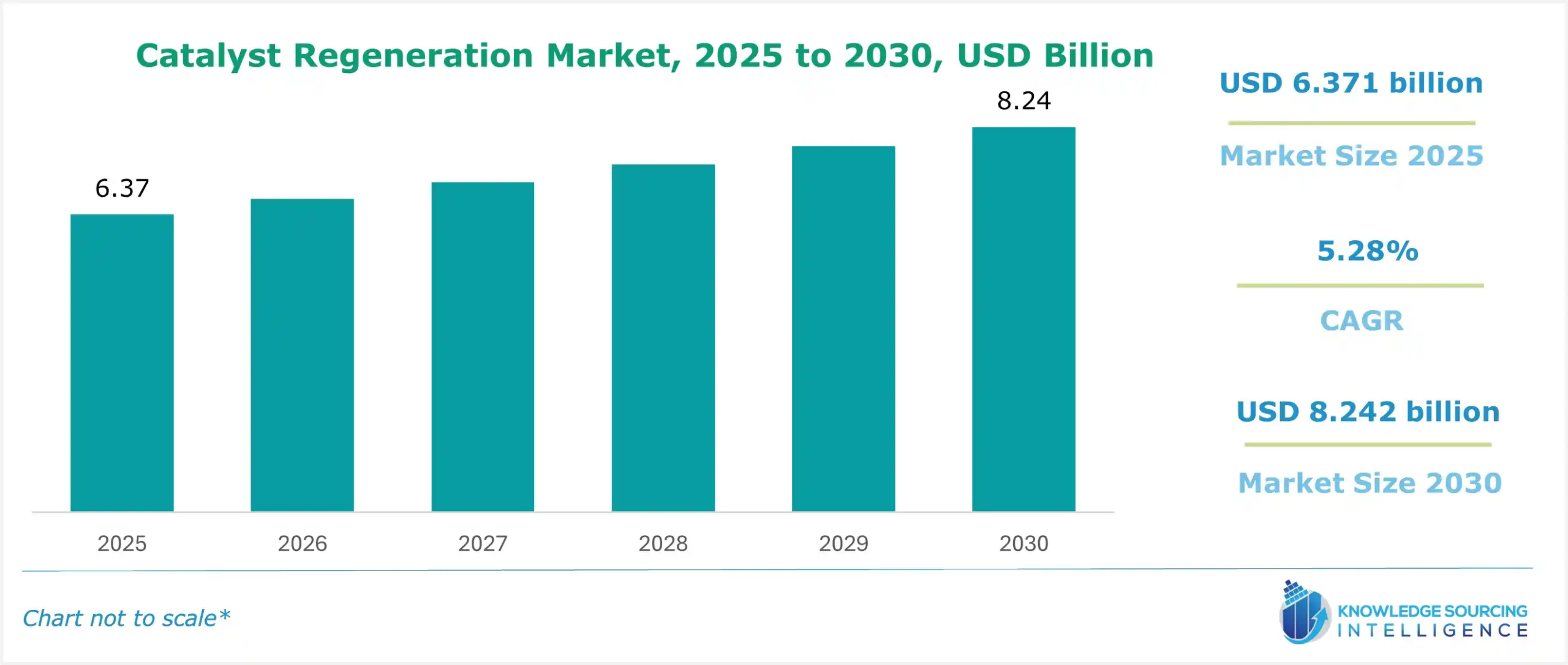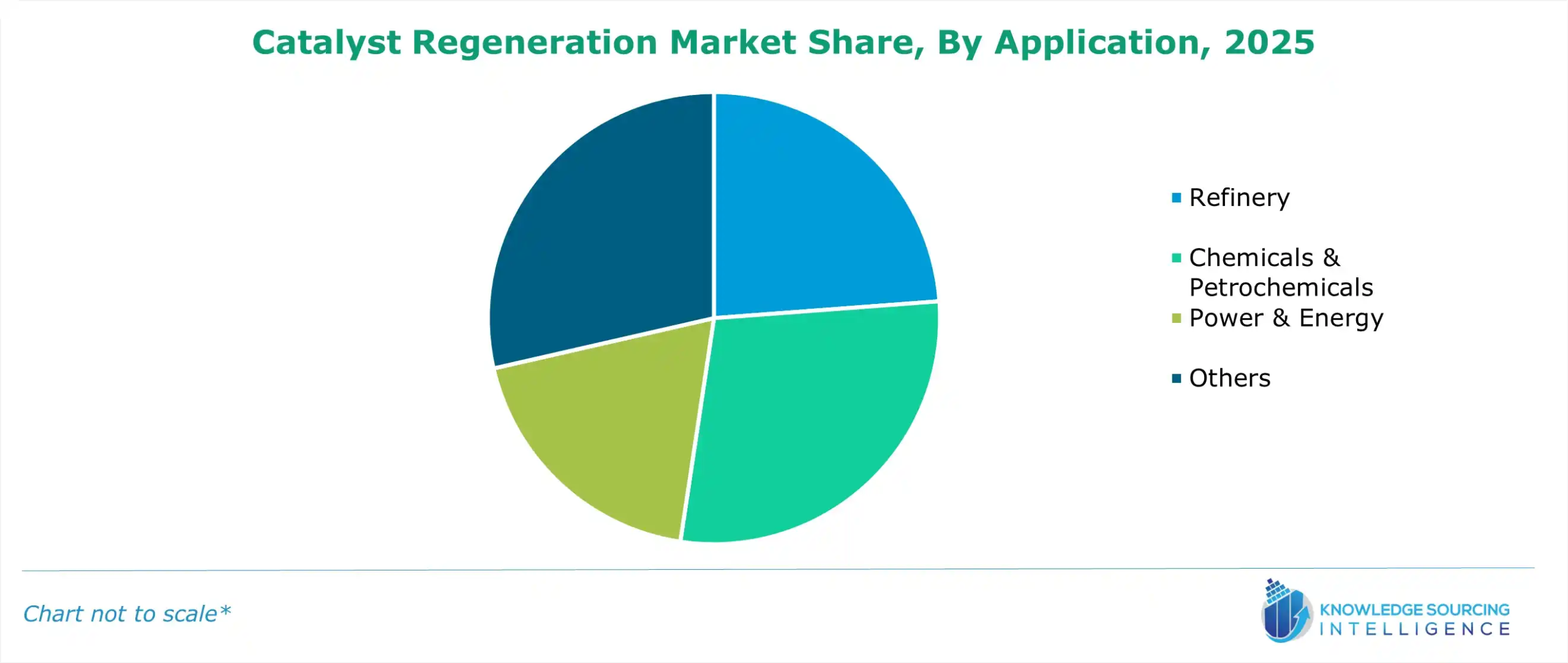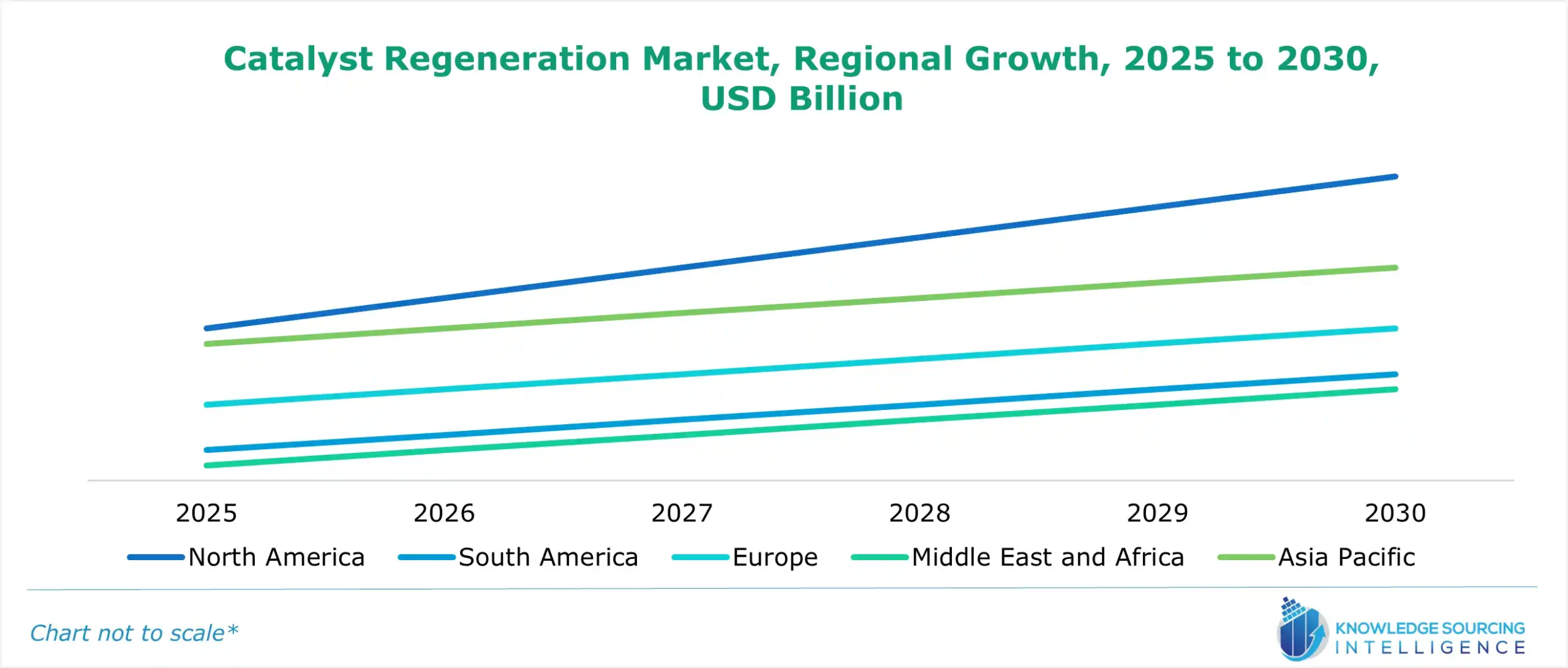Catalyst Regeneration Market Size, Share, Opportunities, And Trends By Type (Agricultural Grade, Industrial Grade), By Application (Agriculture, Industrial, Others), And By Geography - Forecasts From 2025 To 2030
- Published : Dec 2024
- Report Code : KSI061617179
- Pages : 140
Catalyst Regeneration Market Size
The catalyst regeneration market is expected to grow at a CAGR of 5.28%, reaching a market size of US$8.242 billion in 2030 from US$6.371 billion in 2025.

Catalyst regeneration is the process that employs methods of reviving a de-activated or deteriorated catalyst formed as a result of causes such as fouling, poisoning, and sintering associated with chemical reactions. Techniques used include washing, oxidation, or thermal treatment, eliminating impurities, and restoring the surface properties. It is widely applied in refineries, petrochemical industries, and environmental management, where catalysis is essential for an efficient process and must be cycled to avoid loss and promote cost-effectiveness and sustainability.
Growing applications for catalyst regeneration in the petroleum refining and industrial sectors are anticipated to propel market growth in the projected period. For instance, according to the Ministry of Petroleum & Natural Gas, Indian refining capacity has increased from 215.5 Million Metric Tonnes per Annum (MMTPA) to 256.8 MMTPA in the past 10 years. In 2023-24, the total refining capacity was 256.8 MMTPA, and the domestic consumption of petroleum products in 2023-24 was 233.3 MMTPA. By 2028, India’s petroleum refining capacity is expected to increase to 309.5 MMTPA. Additionally, according to the Ministry of Statistics and Programme Implementation (MoSPI), the gross value added from manufacturing coke and refining products was INR1.56 lakh crore in 2013-14, which increased to INR2.12 lakh Crore in 2022-23. This increase also contributed to All India's GDP from INR99.44 lakh crore to INR269.49 lakh crore in the corresponding year, at current prices. Hence, with the growing refining sector, the catalyst regeneration market is anticipated to grow.
Furthermore, catalyst regeneration market growth will be fuelled positively by increasing application in areas such as the chemical synthesis process and a greater focus on the development of cost-effective regeneration technologies. Hence, the growth and expansion in various end-user industries, particularly in developing economies, are anticipated to propel the catalyst regeneration market in the projected period.
What are the catalyst regeneration market drivers?
- Catalyst regeneration is used in hydrogen production processes, especially in conventional steam methane reforming (SMR), as well as less conventional partial oxidation and autothermal reforming. These processes usually use nickel-based catalysts, converting hydrocarbon-hydrogen-like natural gas into hydrogen. The growing hydrogen production is expected to grow the market for catalyst regeneration in the coming years. For instance, according to the International Renewable Energy Agency (IRENA), the global production of pure hydrogen in 2022 stood at 75 MtH2/yr and 45 MtH2/yr as a part of mixed gases.
- Moreover, catalyst regeneration is mainly used for oil and fat hydrogenation in the food processing sector. It also serves as the process where metals, like nickel, cause chemical changes in unsaturated fats. The growing market for the food processing sector is anticipated to fuel the market for catalyst regeneration in the coming years. For instance, according to the Indian Brand Equity Foundation (IBEF), the gross value added (GVA) in the food processing sector increased from INR1.61 lakh crore in 2015-16 to INR1.92 lakh crore in 2022-23, as per First Revised Estimates of Ministry of Statistics and Programme Implementation.
- Additionally, catalyst regeneration has found wide application in the chemical industry to extend the life of catalysts in industrially important reaction processes such as ammonia synthesis, methanol synthesis, and polymerization. The manufacturers of chemicals, through the regeneration of deactivated catalysts by thermic, washing, or chemical treatment, can maintain production efficiency and minimize costs associated with operations. Catalyst replacement, which is a costly operation that requires significant time, is reduced through regeneration, supports sustainability, and limits waste and raw materials.
- The chemical sector in various countries is developing and growing, propelling the market for catalyst regeneration in the forecasted period. For instance, according to the Cybersecurity and Infrastructure Security Agency (CISA), the United States Chemical industry is a US$768 billion enterprise that supports more than 25% of the country’s GDP. Similarly, according to the Ministry of Chemicals and Fertilizer, the Indian chemical and petrochemical sector holds a significant position and is attracting foreign investment. The chemical and petrochemical sector was valued at US$178 billion and is expected to increase to US$300 billion by 2025. Hence, the increasing use of catalyst regeneration in various end-use sectors is anticipated to fuel its market in the projected period.
Segment analysis of the catalyst regeneration market:
- By type, the on-site regeneration segment is expected to hold a significant share of the catalyst regeneration market.
By type, the catalyst regeneration market is segmented into on-site regeneration and off-site generation. The on-site regeneration segment is expected to hold significant market share in the projected period, as it allows companies to effectively recover the catalyst activity within their plants, thus maintaining continuity in production. At the same time, efficiency is improved, especially for high-capacity industries like petrochemicals and refining. On-site methods also provide more flexibility and tailoring towards specific operations needs, thus granting quicker response times to production demands.

- By application, the refinery segment is expected to hold a significant share of the catalyst regeneration market.
By application, the catalyst regeneration market is segmented into chemical and petrochemical, refinery, power and energy, and others. The refinery sector is anticipated to hold a substantial share of the growing refining capability in developing countries, with the ongoing increase in the strict regulations related to the disposal of spent catalysts. Moreover, in the projected period, the rising application of catalyst regeneration in various industries is anticipated to positively influence market growth.
- The Asia Pacific region is anticipated to hold a significant share in the coming years.
The Asia Pacific region is expected to dominate the catalyst regeneration market in the coming years, as the region has some of the fastest-growing economies, such as India and China. Furthermore, the increasing per capita income coupled with growing segments such as refining, chemical, and petrochemical are expected to fuel the Asia Pacific market in the forecasted period. For instance, according to the International Energy Agency, China’s oil refining product sector increased from 2,87,84,257 TJ in 2020, which increased to 2,92,74,286 TJ in 2022. Hence, these factors are expected to fuel the market for catalyst regeneration in the forecasted period.

Copper ammonium carbonate market scope:
| Report Metric | Details |
| Catalyst Regeneration Market Size in 2025 | US$6.371 billion |
| Catalyst Regeneration Market Size in 2030 | US$8.242 billion |
| Growth Rate | CAGR of 5.28% |
| Study Period | 2020 to 2030 |
| Historical Data | 2020 to 2023 |
| Base Year | 2024 |
| Forecast Period | 2025 – 2030 |
| Forecast Unit (Value) | USD Billion |
| Segmentation |
|
| Geographical Segmentation | North America, South America, Europe, Middle East and Africa, Asia Pacific |
| List of Major Companies in Catalyst Regeneration Market |
|
| Customization Scope | Free report customization with purchase |
The Catalyst Regeneration market is analyzed into the following segments:
- By Type:
- On-site regeneration
- Off-site regeneration
- By Application:
- Refinery
- Chemicals & Petrochemicals
- Power & Energy
- Others
- By Geography:
- North America
- USA
- Canada
- Mexico
- South America
- Brazil
- Argentina
- Others
- Europe
- UK
- Germany
- France
- Italy
- Others
- Middle East and Africa
- Saudi Arabia
- Israel
- Others
- Asia Pacific
- Japan
- China
- India
- South Korea
- Indonesia
- Thailand
- Others
- North America
Frequently Asked Questions (FAQs)
The catalyst regeneration market is expected to reach a total market size of US$8.242 billion by 2030.
Catalyst Regeneration Market is valued at US$6.371 billion in 2025.
The catalyst regeneration market is expected to grow at a CAGR of 5.28% during the forecast period.
The Asia Pacific region is anticipated to hold a significant share of the catalyst regeneration market.
The catalyst regeneration market has been segmented by type, application, geography.
1. INTRODUCTION
1.1. Market Overview
1.2. Market Definition
1.3. Scope of the Study
1.4. Market Segmentation
1.5. Currency
1.6. Assumptions
1.7. Base and Forecast Years Timeline
1.8. Key Benefits for the Stakeholders
2. RESEARCH METHODOLOGY
2.1. Research Design
2.2. Research Process
3. EXECUTIVE SUMMARY
3.1. Key Findings
3.2. Analyst View
4. MARKET DYNAMICS
4.1. Market Drivers
4.2. Market Restraints
4.3. Porter’s Five Forces Analysis
4.3.1. Bargaining Power of Supplier
4.3.2. Bargaining Power of Buyers
4.3.3. The Threat of New Entrants
4.3.4. Threat of Substitutes
4.3.5. Competitive Rivalry in the Industry
4.4. Industry Value Chain Analysis
5. CATALYST REGENERATION MARKET BY TYPE
5.1. Introduction
5.2. On-site regeneration
5.3. Off-site regeneration
6. CATALYST REGENERATION MARKET BY APPLICATION
6.1. Introduction
6.2. Refinery
6.3. Chemicals & Petrochemicals
6.4. Power & Energy
6.5. Others
7. CATALYST REGENERATION MARKET BY GEOGRAPHY
7.1. Introduction
7.2. North America
7.2.1. USA
7.2.2. Canada
7.2.3. Mexico
7.3. South America
7.3.1. Brazil
7.3.2. Argentina
7.3.3. Others
7.4. Europe
7.4.1. UK
7.4.2. Germany
7.4.3. France
7.4.4. Italy
7.4.5. Others
7.5. Middle East and Africa
7.5.1. Saudi Arabia
7.5.2. Israel
7.5.3. Others
7.6. Asia Pacific
7.6.1. Japan
7.6.2. China
7.6.3. India
7.6.4. South Korea
7.6.5. Indonesia
7.6.6. Thailand
7.6.7. Others
8. COMPETITIVE ENVIRONMENT AND ANALYSIS
8.1. Major Players and Strategy Analysis
8.2. Market Share Analysis
8.3. Mergers, Acquisitions, Agreements, and Collaborations
8.4. Competitive Dashboard
9. COMPANY PROFILES
9.1. CORMETECH
9.2. EBINGER Katalysatorservice GmbH & Co. KG
9.3. Eco-Rigen S.r.l.
9.4. EURECAT
9.5. NIPPON KETJEN Co.,Ltd
9.6. Yokogawa Corporation of America
9.7. Rezayat Group
9.8. REMONDIS SE & Co. KG
9.9. Nel ASA
9.10. Albemarle Corporation
CORMETECH
EBINGER Katalysatorservice GmbH & Co. KG
Eco-Rigen S.r.l.
EURECAT
NIPPON KETJEN Co.,Ltd
Yokogawa Corporation of America
Rezayat Group
REMONDIS SE & Co. KG
Nel ASA
Albemarle Corporation
Related Reports
| Report Name | Published Month | Download Sample |
|---|---|---|
| Emission Control Catalyst Market: Size, Trends, Forecast 2030 | Dec 2024 | |
| Refining Catalysts Market Size & Share: Industry Report, 2022 - 2027 | Sep 2022 | |
| FCC Catalyst Market Size & Share: Industry Report, 2023 – 2028 | Apr 2023 | |
| Photocatalyst Market Size & Forecast 2025-2030 | Free Sample | Dec 2024 | |
| Polyolefin Catalyst Market Size & Forecast 2025-2030 | Free Sample | Dec 2024 |



